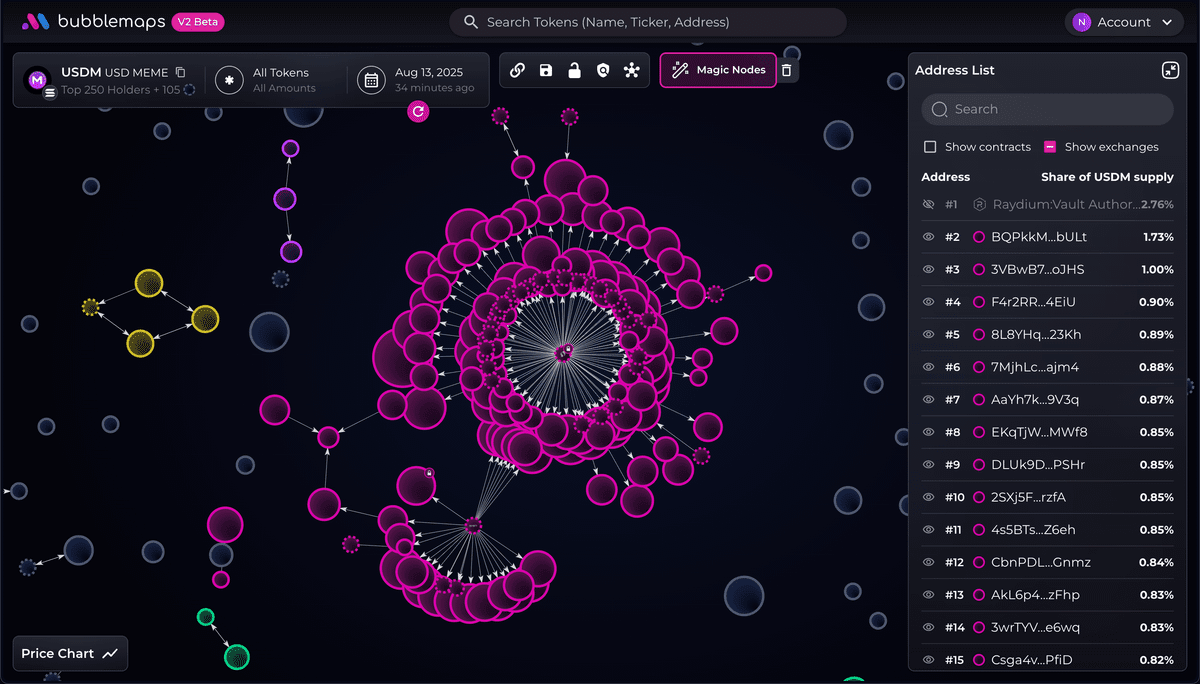Recently, the hot topic is Kanye's cryptocurrency, which has seen a significant drop lately. However, after many people used Bubblemaps to look at the related data, they chose not to buy it!
Bubblemaps transforms raw on-chain data into a 'bubble-edge' relationship map, presenting the concentration of holdings, address clusters, and transfer paths in an intuitive way. This capability is naturally suited to upgrade into a 'compliance-trading' bidirectional engine: one end faces regulation and auditing, providing interpretable evidence maps; the other end faces trading and market making, offering executable risk control strategies and thresholds. The core change is not in 'seeing', but in 'operability'.
Before listing coins, applying for liquidity, and establishing DEX pools, project parties often disclose only minimal information: initial distribution, attribution plans, and lock-up ratios. Bubblemaps can convert this set of static disclosures into dynamic proofs: real-time tracking of the migration trajectory of attribution wallets, staking/unlocking actions, and sub-wallet decentralized transfers (common in splitting chips to avoid concentration detection). After binding the visualization layer with the rules engine, a BubbleScore is formed: scoring patterns such as 'same-source fund aggregation', 'circular transfer disguised as decentralization', and 'concentrated selling pressure at key points', which is called by the pre-trade routing, directly affecting market making depth, price spread, limits, and matching priority. The graph is not a report but an input for trading parameters.
In the secondary market scenario, the biggest pain point for market makers is 'who is the counterparty'. The cluster detection of Bubblemaps can be extended to counterparty identification and relative risk pricing: if the same group of addresses dominates both sides of the liquidity pool, the market making curve needs steeper inventory protection; if abnormal coupling with bridging contracts or cross-chain routing is detected, the system automatically adjusts the slippage and risk control margin. For CEX/DEX aggregators, the graph engine connects to the routing layer, enabling the addition of threshold strategies (price limits, quantity limits, delayed settlement) for 'suspicious fund flows' at millisecond levels, forming pre-trade risk gates. This mechanism can directly reduce tail risks more effectively than retrospective tracing.
On the compliance side, Bubblemaps excels in 'explainability of evidence'. Traditional on-chain monitoring often relies on stacked hashes and labels, making it difficult to present in one graph 'how funds are controlled by a minority group'. Important nodes (team wallets, early private placements, market making cold/hot wallets, bridging contracts) are abstracted into bubbles of different levels, with edges carrying time series and amount changes, and labeled with 'consecutive buy/sell segments' akin to a stock trading platform, quickly forming behavioral fingerprints. This provides a unified language for exchanges' coin listing due diligence and penetration checks for MiCA/Travel Rule: not only seeing 'who', but also displaying 'what was done, when, and how much impact'.
To upgrade the graph from 'analysis interface' to 'market infrastructure', two cutting-edge extensions are needed. The first is the bridging of on-chain commitments and off-chain audits: project parties generate Merkle proofs of 'allocation-attribution-lock-up' commitments during deployment, and Bubblemaps is responsible for maintaining commitment status on-chain and providing 'commitment fulfillment rate' in the graph. Auditing agencies issue signed 'allocation behavior proofs' (Attestation) based on this, forming composable compliance NFTs that are invoked by exchanges and fund parties. The second is zero-knowledge concentration proofs: teams and institutions can present ZK proofs showing 'the holding ratio of a specific aggregated wallet group does not exceed X%' without exposing all addresses; the graph side only displays pass/fail and interval estimates, satisfying transparency while protecting privacy.
The Intel Desk and $BMT can play a key role in governance and gaming along this path: researchers submit investigations on 'suspicious clusters', staking BMT to bind the credibility of conclusions; if subsequently overturned by on-chain facts, the stake is penalized and transferred to a correction pool, incentivizing 'reviewers' in reverse. Compliance scoring, trading thresholds, and market making quotas can also be bound with BMT, forming a closed loop of 'research-risk control-liquidity'. Thus, Bubblemaps is not only a graphical reader but also becomes a protective layer and compliance clearing layer for the market, transforming 'understanding' into 'actionable'.
The next step, which is not yet complete but closely related, is to bring the graph indicators to the forefront of the launch pad and liquidity guidance (LFG) platform: projects must pass a minimum BubbleScore before entering the submission pool, and unlocked funds must be tied to verifiable 'destination strategies' (market making/incentives/repurchase), displayed on the graph as 'usage layer'; once deviating from the committed trajectory, routing automatically lowers the tradable limit and triggers community review. With visualization as the interface and rules as the core, Bubblemaps can synthesize 'compliance' and 'trading' from two departmental terms into a real-time operating market protocol. @Bubblemaps.io #Bubblemaps $BMT
